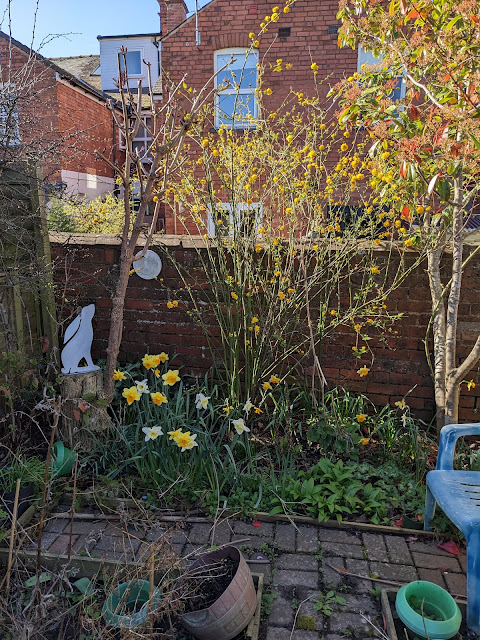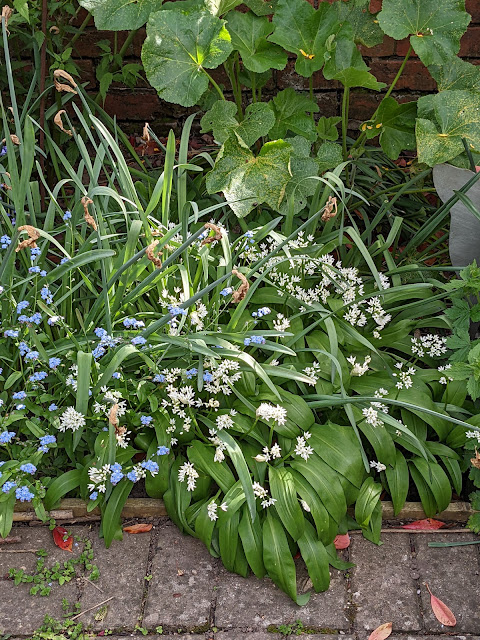 |
| Photo 1: Wild Garlic in the Secret Garden (27/3/23) |
Wild garlic (allium ursinum) is an easy herb to grow if you have a shady damp spot. We have a patch at the bottom of the Secret Garden (aka the Wild Garden) where it thrives beneath a north-facing wall; see Photo 1, the wild garlic is betwixt the daffodils and the blue chair.
 |
| Photo 2: Flowering Wild Garlic in the Secret Garden (5/5/22) |
Use the leaves and flowers as an alternative to culinary garlic (allium sativum) during winter and spring [1, 2]. Wild garlic is also a useful companion plant for fruit trees, tomatoes, peppers, aubergines, brassicas, soft fruit, and beets where it deters pests such as aphids. However, you should not plant near legumes or asparagus where it will stunt their growth. Both the culinary and the wild garlic exhibit a protective/offensive effect.
I would be interested in planting around my fruit trees as a form of pest control while also providing an edible crop. I foresee two problems, however. Firstly, fruit trees tend to be grown in sunny areas that are not ideal for wild garlic which prefers damp and shade. Culinary garlic is perfectly happy in the sun but is grown as an annual and you do not want to be regularly disturbing the fruit tree roots by replanting every year. Onions are often grown with other fruit & vegetables as a companion plant but the same issue arises as with culinary garlic. I have a small patch of Egyptian Walking Onions (Photo 3)sharing the fruit bed (currants, gooseberries, apples and pears); they just look after themselves, have a sunny disposition and may offer some pest control.
 |
| Photo 3: Egyptian Walking Onions in the Fruit Area |
The second problem I envisage is that certain plants (legumes and asparagus to name but two) may suffer in the presence of garlic (wild or otherwise). In a small kitchen garden using a crop rotation system, it is not always feasible to keep these incompatibles apart. Also bear in mind that companion planting is not an exact science; while we know quite a lot there are still disagreements on, for example, whether garlic and strawberries are companions or not.
Mary commented that the daffodils at the bottom of the garden (Photo 1) were less prolific this Spring than in previous years. And, she wondered whether the wild garlic was suppressing them in some way. I could not find any reference to wild garlic affecting daffodils in a detrimental way though the former do provide extensive groundcover which might impact daffodil development. In any case, I decided to look back at previous years to see whether there were noticeable differences in the floriferousness of the daffodils. Here is a picture from March 25th 2022 ...
 |
| Photo 4: Wild Garlic & Daffodil Patch (25/3/22) |
This year's daffodil display does appear somewhat diminished compared with 2022 but then so is that of the Kerria japonica in the background. Looking back to Spring 2021 (Photo 5), the daffodil blooms were even more prominent - it was slightly earlier (about a week) and the japonica flowers had yet to open. From Photos 1, 4 and 5, it is obvious the wild garlic patch is spreading each year. It is difficult to say whether the spreading wild garlic has affected the daffodils - we may just be observing season-to-season variability. I know Mary is of a mind to dig up the wild garlic and move it to another location.
 |
| Photo 5: Wild Garlic & Daffodil Patch (18/3/21) |






0 comments:
Post a Comment